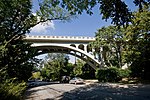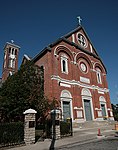Cincinnati Playhouse in the Park

The Cincinnati Playhouse in the Park is a regional theatre in the United States. It was founded in 1959 by college student Gerald Covell and was one of the first regional theatres in the United States. Located in Eden Park, the first play that premiered at the Playhouse on October 10, 1960, was Meyer Levin's Compulsion. The Playhouse has maintained a regional and national reputation in the theatre community for bringing prominent plays to Cincinnati and for hosting national premieres such as Tennessee Williams' The Notebook of Trigorin in 1996 and world premieres such as the Pulitzer Prize-nominated Coyote on a Fence in 1998 and Ace in 2006.The Playhouse facility comprises two theatres, the larger Robert S. Marx Theatre and the smaller Shelterhouse. The Playhouse is among the members of the League of Resident Theatres. In addition to a full ten-month season of plays, the Playhouse also offers acting classes and programs for children. In 1973-1975, the Playhouse was the first professional regional theatre to be led by Harold Scott.Scott was followed by Michael Murray, who was artistic director at the Playhouse until 1985. Murray was co-founder of the Charles Playhouse in Boston and is one of the early leaders of the Regional Theatre Movement. The Playhouse was under the leadership of Edward Stern (Producing Artistic Director) and Buzz Ward (Executive Director) between 1992 and 2012. In 2012, Blake Robison became artistic director and Buzz Ward was promoted to managing director.In 2004, the Playhouse received a Tony Award for Best Regional Theatre. In 2007, the Playhouse received a second Tony Award for their revival of Company, which won Best Revival of a Musical. The production was directed by John Doyle and also won Drama Desk, Outer Critic's Circle and Drama League Awards for Best Revival of a Musical. The Shelterhouse theatre was named for Jay Thompson until 2017 and will be renamed the Rosenthal Shelterhouse Theatre in 2019.Currently Mount Adams, home of the Cincinnati Art Museum and Cincinnati Playhouse in the Park, is undergoing major renovation that will result in beautiful approaches to the summit. https://www.bizjournals.com/cincinnati/news/2020/05/07/cincinnati-art-museum-to-unveil-first-phase-of-art.html
Excerpt from the Wikipedia article Cincinnati Playhouse in the Park (License: CC BY-SA 3.0, Authors, Images).Cincinnati Playhouse in the Park
Mount Adams Circle, Cincinnati Walnut Hills
Geographical coordinates (GPS) Address Website External links Nearby Places Show on map
Geographical coordinates (GPS)
| Latitude | Longitude |
|---|---|
| N 39.111227777778 ° | E -84.497744444444 ° |
Address
Cincinnati Playhouse in the Park
Mount Adams Circle 362
45202 Cincinnati, Walnut Hills
Ohio, United States
Open on Google Maps










